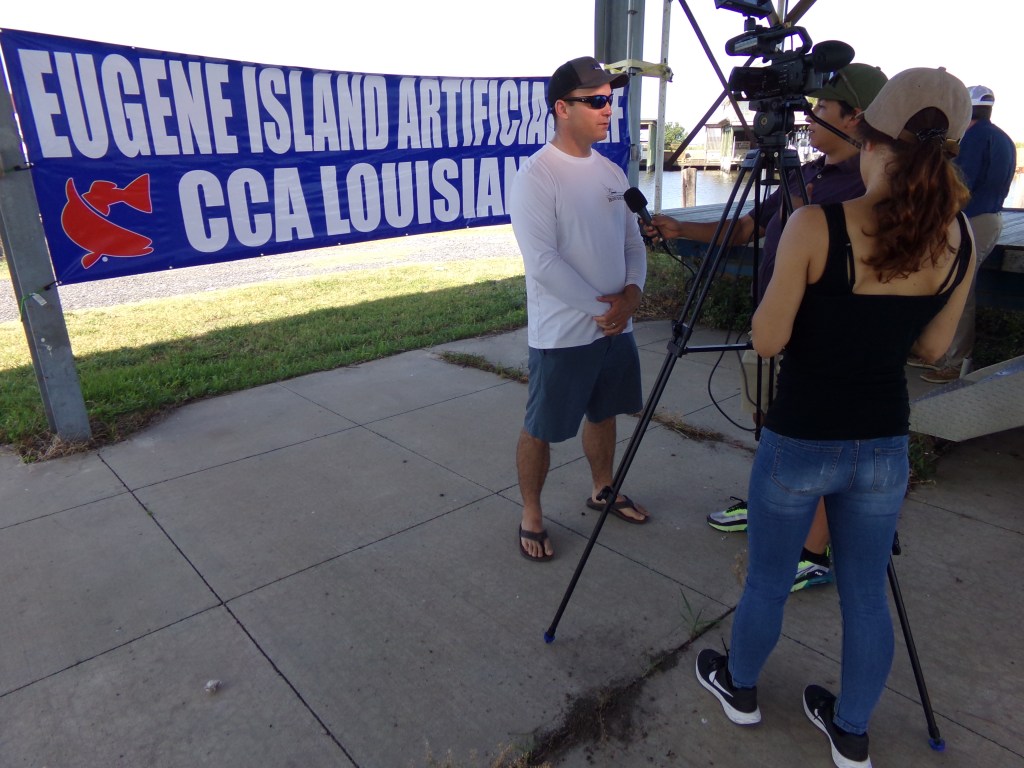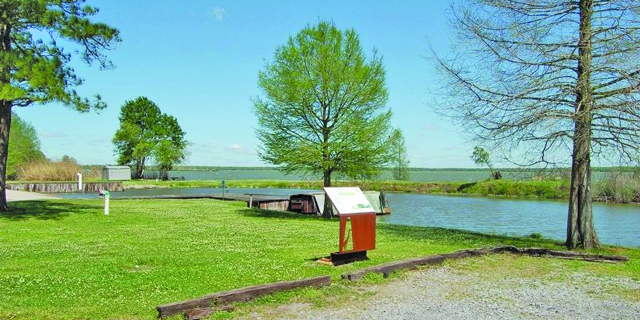Acadiana’s near-offshore fishermen will appreciate new EI 51 artificial reef
Published 1:00 am Sunday, June 26, 2022

- Stuart Billeaud of Lafayette, a state board member with CCA-Louisiana and past president of the Lafayette-based Acadiana Chapter, talks Wednesday about construction of an artificial reef that got underway this past week at Eugene Island 51. Billeaud attended a dedication ceremony at Cypremort Point before riding with media and guests to the former site of the oil field platform in the Gulf of Mexico.
CYPREMORT POINT — A few generations of Acadiana saltwater fishermen enjoyed catching speckled trout at Eugene Island 51 before it was removed from its location in the Gulf of Mexico.
Thanks to Coastal Conservation Association of Louisiana, its partners and supporters, many more generations will have the opportunity to tap the fish population 21 miles from Marsh Island. CCA-Louisiana. CCA-Louisiana’s REEF Louisiana program started building an artificial reef there this past week.
Trending
One of those saltwater fishermen is Rep. Stuart Bishop, R-Lafayette. Bishop, who was born and raised in Jeanerette and graduated from Hanson Memorial High School, spoke Wednesday at a dedication ceremony here before David Bell’s 46-foot Invincible powered by four 400-h.p. Mercury outboard motors ferried officials, guests and media to the site.
“My family and I spent many days and nights fishing these platforms, and I will never forget the good times we had. Being here today, seeing these CCA volunteers and partners who are dedicated to making a difference, makes me really pleased. I can’t wait to fish this new reef with my family,” Bishop said in an interview with CCA-Louisiana.
Bishop later told a local outdoors writer the project was significant and struck close to home because of his family’s history. His paternal grandfather, Don Bishop, moved the family’s camp along Bird Island Chute in Lake Fausse Pointe to Cypremort Point. And, he said, his maternal grandfather, Beverly Fournier, was the foreman for Kerr-McGee Oil Industries Inc. after the company acquired eight offshore Louisiana lease blocks in 1946 and made history in the Gulf of Mexico by completing the first commercially productive well drilled out of sight of land in 1947, coincidentally 15 miles from what later would become EI 51.
“So this is a legacy for my family, my children and the state of Louisiana. I grew up here. I’m never leaving here. I want my children to experience all the great experiences I grew up with. I want them to be able to experience all the great things the Louisiana coast has to offer as well. It’s a phenomenal project,” Bishop said.
Legislative support from Bishop and Sen. Bret Allain, R-Franklin, has been crucial to this and other artificial reef projects, according to CCA-Louisiana CEO David Cresson.
“Years ago, Sen. Allain and Rep. Bishop had the foresight to drive legislation that dedicated Artificial Reef Trust Fund dollars for near-shore and inshore projects like this. That leadership makes it possible for funding from CCA and partners like Chevron to be matched by the Artificial Reef Trust Fund, allowing us to maximize the size and scope of these projects. They simply would not happen without what Sen. Allain and Rep. Bishop did years ago,” Cresson said in a prepared statement after the event.
Trending
EI 51 was dismantled and taken out in 2012. The removal left a void where there once was optimal fish habitat on the floor of the Gulf.
Morgan City-based Atchafalaya Chapter of CCA-Louisiana and chapter president Dicky Fitzgerald of Charenton, an all-around outdoorsman who has a State Farm Agency in Morgan City, first proposed an artificial reef project for Eugene Island 51. The project was approved by CCA-Louisiana’s Habitat and Conservation Committee.
John Walther of Thibodaux, vice president of the Habitat and Conservation Committee, said, “We worked closely with our Atchafalaya Chapter and Wildlife and Fisheries to choose and approve this site, in a place that once was a favorite for local anglers … From there, we approached Chevron and our construction partners to secure funding and plan the project. Once we secured matching funds from the Artificial Reef Trust Fund, it became clear that we could get this done, so here we are today.”
The EI 51 artificial reef’s unofficial coordinates are 29degrees14.853’ N, -91degrees41/875’ W.
The new reef will cover the footprint of old oil field structures there in an effort to get the most out of the water and bottom conditions and create the best possible fish habitat, Cresson said before the trip.
Filling the gaps were an estimated 300-400 pieces of concrete bridge piling cutoffs and the same amount of concrete pipeline weights, according to John Fell of Scott, CCA-Louisiana member/volunteer and owner of Roadrock Recycling Inc. in New Iberia.
Including EI 51, his company has been involved with 12 artificial reefs, he said as he watched the heavy equipment drop concrete pieces.
Chad Courville of Lafayette fished the original platform, situated above a natural shoal in 15- to 17-foot depths, for many years. He called it “pretty special,” but has a soft spot in his heart for another artificial reef at Vermilion 119 and 124 called the Rawls Reef Complex, named after his grandfather, Jim Rawls, and built in 2019.
A local outdoors writer who wrote a weekly fishing report in the late 1970s, ’80s and ’90s remembers vividly remembers that the leading near-offshore speckled trout fishing destination. EI 51 and Eugene Island 74, six miles away, consistently gave up fish.
Stuart Billeaud of Lafayette knows that all too well, which is why the CCA-Louisiana member and volunteer appreciates the installation of an artificial reef at EI 51. (An artificial reef project also is scheduled for EI 74.)
“This is a very important one. This (EI 51) was one of the top trout spots in the Gulf of Mexico … in the Top 3. They were both really good at night. They had lights (on the platforms),” Billeaud said.
Those Eugene Island oil and gas platforms are among 900-plus rigs approved and scheduled for artificial reef construction off Louisiana’s coast, Cresson said during the dedication ceremony.
John Walters of Baton Rouge, Chevron’s state government affairs official for the east region, is proud his company continues to be involved in the artificial reef projects. EI 51 was the 32nd undertaken by CCA-Louisiana.
“This Eugene Island project is another example of CCA and Chevron working together to promote and protect coastal Louisiana, where our employees and families live, work and play,” Walters said during a break in the dedication ceremony.





